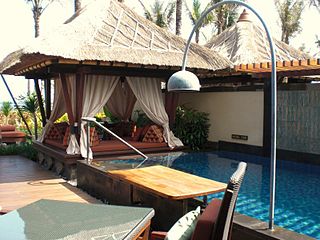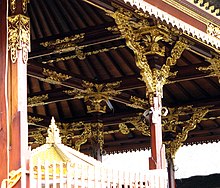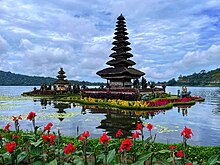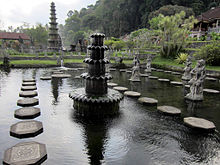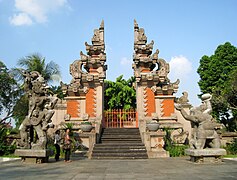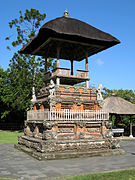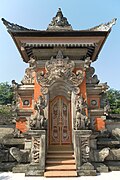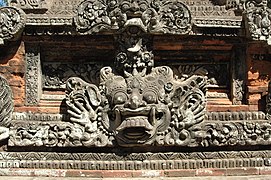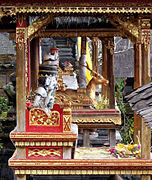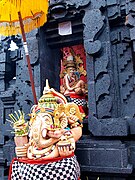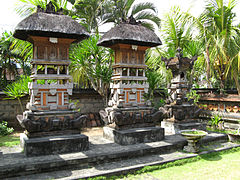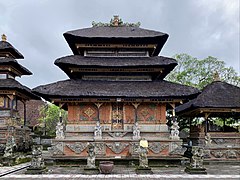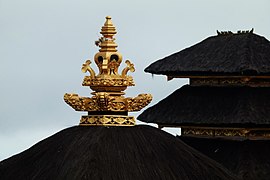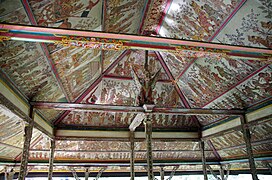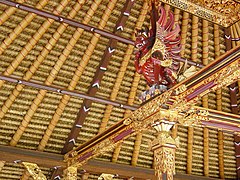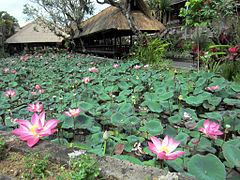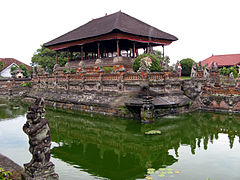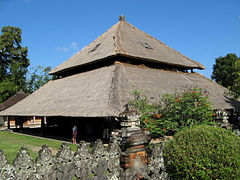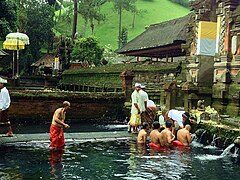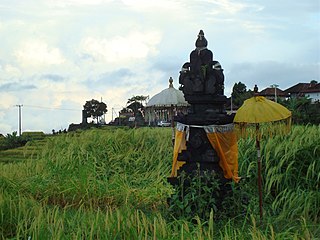
Subak is the water management (irrigation) system for the paddy fields on Bali island, Indonesia. It was developed in the 9th century. For the Balinese, irrigation is not simply providing water for the plant's roots, but water is used to construct a complex, pulsed artificial ecosystem. The system consists of five terraced rice fields and water temples covering nearly 20,000 hectares. The temples are the main focus of this cooperative water management, known as subak.

A candi is a Hindu or Buddhist temple in Indonesia, mostly built during the Zaman Hindu-Buddha or "Hindu-Buddhist period" between circa the 4th and 15th centuries.

Pura Ulun Danu Batur is a Hindu Balinese temple located in the island of Bali, Indonesia. As one of the Pura Kahyangan Jagat, Pura Ulun Danu Batur is one of the most important temples in Bali which acted as the maintainer of harmony and stability of the entire island. Pura Ulun Danu Batur represents the direction of North and is dedicated to the god Vishnu and the local goddess Dewi Danu, goddess of Lake Batur, the largest lake in Bali. Following the destruction of the original temple compound, the temple was relocated and rebuilt in 1926. The temple, along with 3 other sites in Bali, form the Cultural Landscape of Bali Province which was inscribed as World Heritage Site by UNESCO in 2012.

A Pura is a Balinese Hindu temple, and the place of worship for adherents of Balinese Hinduism in Indonesia. Puras are built following rules, style, guidance, and rituals found in Balinese architecture. Most puras are found on the island of Bali, where Hinduism is the predominant religion; however many puras exist in other parts of Indonesia where significant numbers of Balinese people reside. Mother Temple of Besakih is the most important, largest, and holiest temple in Bali. Many Puras have been built in Bali, leading it to be titled "the Island of a Thousand Puras".
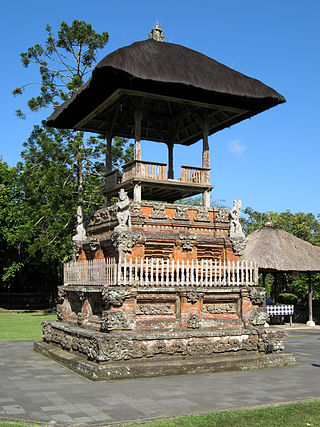
The bale kulkul or bale kul-kul is a Balinese pavilion where a slit-log drum is placed. It is essentially a drum tower or a watch tower. A bale kulkul can has a civic function, such as those used in villages as a mean of communication; or for religious function, an integral part of Balinese temple architecture.

Candi bentar, or split gateway, is a classical Javanese and Balinese gateway entrance commonly found at the entrance of religious compounds, palaces, or cemeteries in Indonesia. It is basically a candi-like structure split perfectly in two to create a passage in the center for people to walk through. In contrast to the very ornate shape and decoration of the main faces, the sides of the passage are left completely plain. The passage is usually elevated with a flight of stairs to reach it. A candi bentar is commonly found in Java, Bali, and Lombok.

A wantilan is a Balinese pavilion (bale) used for activities involving large crowds. A wantilan is the largest type of bale in Balinese architecture. A wantilan is basically a large wall-less hall placed under a large multi-tiered roof. A wantilan as a public building is usually located at a village's main square or main junction and functions as an open hall to hold large community activities such as meeting halls or a public musical gamelan performance. A wantilan is also a religious building, an integral part of Balinese temples used to hold the Balinese cockfighting ceremony.

Paduraksa, also known as kori is a type of gateway covered with towering roof that can be found in the island of Java and Bali, Indonesia. This architectural feature is commonly found in buildings from the classical Hindu-Buddhist period of Indonesia. Paduraksa marks the threshold into the most sacred space within a religious compound, a cemetery, or a palace. In Balinese architecture, an elaborately decorated towering paduraksa is often built as the temple's most imposing structure.
Pura Griya Sakti is a Balinese Hindu temple located in the village of Manuaba, Kenderan administrative village, Tegalalang subdistrict, Gianyar Regency, Bali. The district is known for its woodcarving and its terraced rice field. The small village of Manuaba is about 4 km north of Kenderan or about 2.5 km southwest of the town of Tampaksiring with its famed Gunung Kawi temple. Pura Griya Sakti is the main temple of a powerful Brahman caste in the area.

Pura Kehen is a Balinese Hindu temple located in Cempaga, Bangli Regency, Bali. The temple is set on the foot of a wooded hill, about 2 kilometres (1.2 mi) north of the town center. Established at least in the 13th-century, Pura Kehen was the royal temple of the Bangli Kingdom, now the Regency of Bangli.

Pura Goa Lawah is a Balinese Hindu temple or a pura located in Klungkung, Bali, Indonesia. Pura Goa Lawah is often included among the Sad Kahyangan Jagad, or the "six sanctuaries of the world", the six holiest places of worship on Bali. Pura Goa Lawah is noted for built around a cave opening which is inhabited by bats, hence its name, the Goa Lawah or "bat cave".
Pura Dalem Sakenan is a pura located at the north-western shore of Serangan, a small island about 10 kilometres (6.2 mi) south of Denpasar, Bali. Pura Dalem Sakenan is dedicated to [rambut sedhana] and is associated with prosperity. Pura Dalem Sakenan is the focus temple of the 210-day Piodalan festival where in the past processions of pilgrims visited the island on foot or by traditional colorful wooden boats called jukung. With the construction of the bridge connecting the Serangan island with Bali as well as the reclamation of the island, the use of colorful jukung for pilgrimage has died out.
Pura Pulaki is a Balinese Hindu temple or a pura located to the west of Singaraja, Bali, Indonesia. The temple is set on flat land with rocky outcrops as the backdrop. Pura Pulaki is a pura segara or Balinese sea temples, set around the island to form a chain of temples which protect the island.
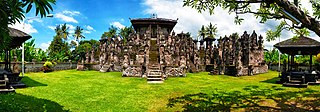
Pura Beji Sangsit is a Balinese temple or pura located in Sangsit, Buleleng, on the island of Bali, Indonesia. The village of Sangsit is located around 8 kilometres (5.0 mi) east of Singaraja. Pura Beji is dedicated to the rice goddess Dewi Sri, and is revered especially by the farmers around the area. Pura Beji is an example of a stereotypical northern Balinese architecture with its relatively heavier decorations than it is southern Balinese counterpart, and its typical foliage-like carvings.

Pura Penataran Agung Lempuyang is a Balinese Hindu temple or pura located in the slope of Mount Lempuyang in Karangasem, Bali. Pura Penataran Agung Lempuyang is considered as part of a complex of pura surrounding Mount Lempuyang, one of the highly regarded temples of Bali. The temples of Mount Lempuyang, represented by the highest pura at the peak of Mount Lempuyang, Pura Lempuyang Luhur, is one of the Sad Kahyangan Jagad, or the "six sanctuaries of the world", the six holiest places of worship on Bali.

Pura Maospahit is a Balinese Hindu temple or pura located in Denpasar, Bali. The pura is known for its bare red brick architecture, reminiscent of the architecture of the 13th-century Majapahit Kingdom, hence the name. Pura Maospahit is the only pura in Bali which was built using a concept known as Panca Mandala where the most sacred area is situated at the center instead of at the direction of the mountain.
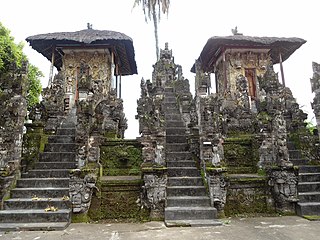
Pura Dalem Segara Madhu also known as Pura Dalem Jagaraga is a northern Balinese Hindu temple or pura located in the village of Jagaraga, Buleleng in northern Bali. It is about 11 km east of Singaraja. The village of Jagaraga is known historically as the place where the Dutch colonial government witnesses puputan or Balinese mass-suicide following their military attack on the kingdom of Bali in 1849. Pura Dalem Segara Madhu is known for its intensive wall decoration typical of northern Balinese architecture and for its unique western-influenced relief e.g. motifs of early 20th-century airplanes and automobiles.

Pura Dasar Buana is a Balinese Hindu temple or pura located in Gelgel, Bali, about 3 kilometres (1.9 mi) from Semarapura. Pura Dasar Buana is one of the Pura Dang Kahyangan Jagat, a temple which was built to honor a holy teacher of Hindu teaching. Pura Dasar Buana honored Mpu Ghana, a Brahmin who arrived to Bali from Javanese Majapahit to teach Hinduism in the island.

Penglipuran Village is one of the traditional villages located in Bangli Regency, Bali Province, Indonesia. Penglipuran village is famous as one of the tourist destinations in Bali because of its society who still preserve their traditional culture in their daily lives. The architecture of buildings and land processing still follows the concept of Tri Hita Karana, the philosophy of Balinese society regarding the balance of relations between God, humans and their environment. Penglipuran Village succeeded in building tourism that benefited all of their communities without losing their culture and traditions. In 1995, Penglipuran Village also received a Kalpataru award from the Indonesian Government for its efforts to protect the Bamboo Forest in their local ecosystem.
